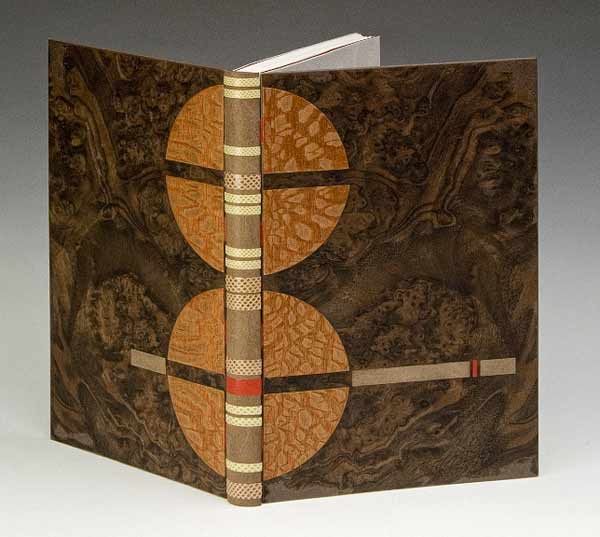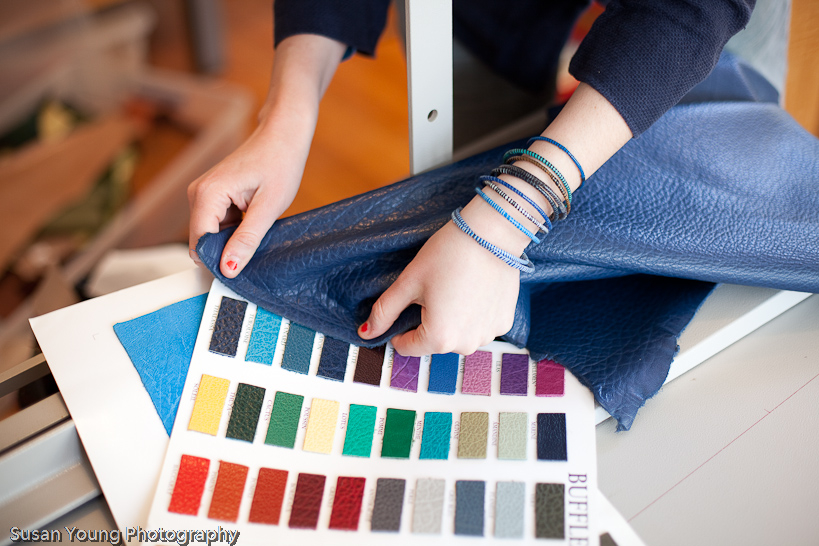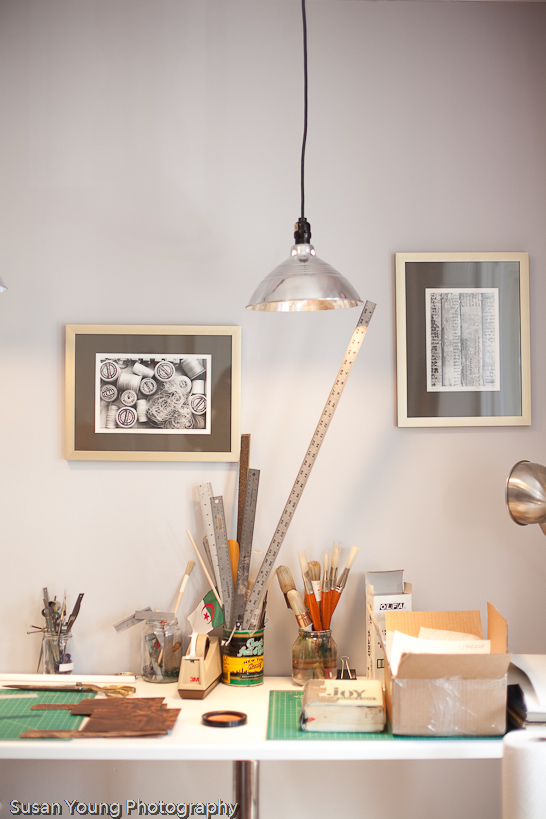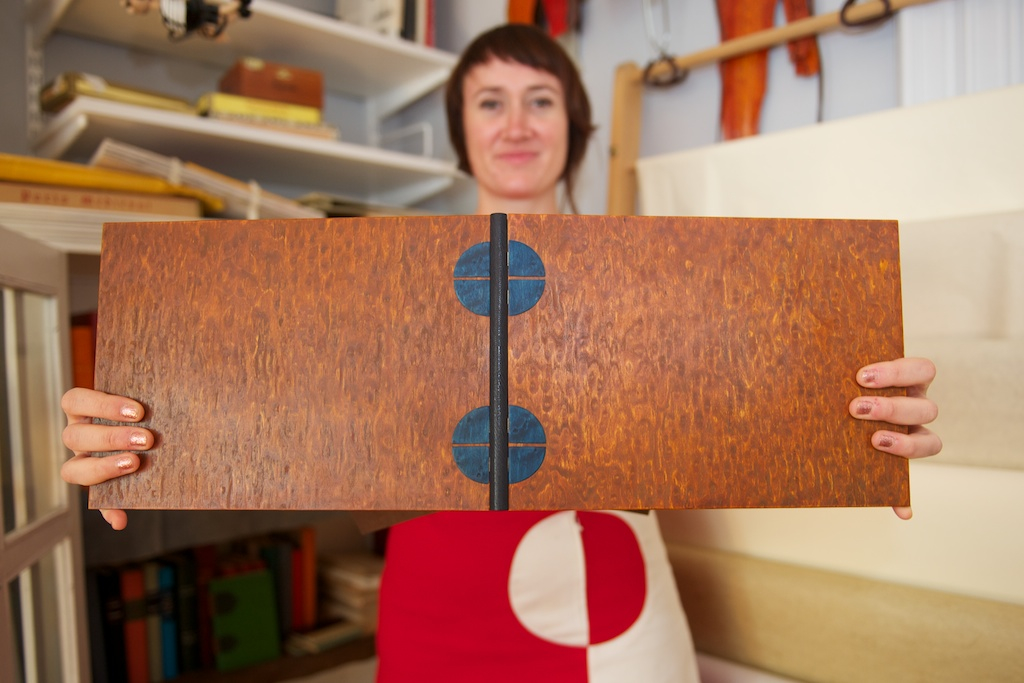La Couleur du Vent is a collection of poems by Gilles Vigneault, illustrated and designed by Nastassja Imiolek under the artistic direction of Cécile Côté. Sonya Sheats bound this copy for an international design binding exhibition organized by ARA-Canada and the École Estienne in Paris. The exhibition is currently on display in Paris until it travels to Quebec and then to Montreal. The exhibition is also viewable online at ARA-Canada: La Couleur du Vent.
Sonya bound this edition as an open joint sewn with tapes made out of vellum and box calf, spine is tanned calf skin with onlaid bands of muted green and taupe water-snake skin and one band of red calf skin, boards in MDF and walnut burl veneer, and onlays in lace wood and calf skin. The subtle accent on red comes straight from the illustrations in the book.
While finishing my second year at North Bennet Street School, Sonya was invited to teach my class the simplified binding structure, a technique she learned from Sün Evrard. Initially, I had the pleasure of meeting Sonya during an open studio event in Cambridge. I was able to tour her space and handle many of her bindings. I am very intrigue and captivated by Sonya’s clean design and level of skill. I would like to thank Sonya for taking the time to share her experiences and skills with me through this interview
Read the interview after the jump and come back each Sunday in the month of June to read more about Sonya’s work.
You began studying bookbinding with Anne Vion in 2000 while living in France. What led you to take this course of study and what level of training did you receive?
My favorite place to spend time is in France. I was born there and spent much of my childhood in the north of France. After graduating from Oberlin College in the US, I decided to take some time for myself before moving on to find a job. My boyfriend at the time, Ben, who is now my husband, had never traveled to France, so we decided to spend 4 months in my family’s home in Brittany. I had no plans while there, but wanted to find a project or work where I would primarily be speaking French because I missed that. My mother had happened upon an announcement for a bookbinding class taught by the local bookbinder, Anne Vion. Anne is originally from Paris and began her career as a teacher, working with students with severe disabilities for 18 years. Her father had been a doctor with a passion for bookbinding. Though he considered himself an amateur hobbyist, he bound over 750 volumes during his life. It was not until after his death that Anne felt a draw toward bookbinding herself. At that time, and probably to some extent even now, it was quite uncommon to change careers later in life in France, however, she decided to enroll at UCAD (Union Centrale des Arts Décoratifs) in Paris in her late 40’s. She completed the two-year CAP (certificat d’aptitude professionnelle) program there as well as an additional year refining her skills under the principal instruction of Alain Lobstein. She then set up a private bindery of her own in 1994 in a small town along the coast of Brittany. Coincidently, and luckily for me, that happened to be the same small town where my parents had a house.
So, in the summer of 2000, I met Anne. Though, I had no experience with bookbinding I was intrigued. I immediately fell in love with her studio, her work, and with her. I was desperate to take the class, though it was already full, so after some begging, she agreed to fit both Ben and me into her class. Things clicked for me during those weeks, and I felt a thrill for the work and the tools we were using. I completed my first three books in that class: a full cloth, a three-quarter binding in chagrin, and a full buffalo. When I completed the class, Anne asked me to stay on with her as she taught one more session and worked through her own pile of commissioned work. I spent three months working side by side with her through piles of books and shadowing her with her clientele.
By the end of my time with her, I had completed the program for the CAP, the professional diploma for bookbinding in France. The training for the CAP focuses the foundational skills in bookbinding, proficiency in structures such as a quarter and full bradel in cloth or paper and quarter binding with corners or bands in leather, slipcases and clamshell boxes, and proficiency in simple titling and tooling as well as décor and composition.
Since your initial training you’ve studied with a variety of bookbinders including Edgard Claes, Sün Evrard, Michel Richard and Florent Rousseau. Can you talk about the array of skills and techniques you learned from each instructor?
After my initial time with Anne, I returned to the US where Ben and I settled in the Boston area. I got a job at Harcourt Bindery on Melcher Street in South Boston and worked there for three months before deciding to try my own luck. I acquired several clients and worked in my home on a variety of books, clamshell boxes, and very small edition projects. I decided I wanted to teach in an elementary school for a stretch, and in 2001, got a part-time job teaching art at a Charter School in Boston and continued to bind books on the side. The following year, I was offered a full-time job teaching art at Cambridge Friends School, a Quaker school, and I held that job until 2010. Teaching was wonderful because I loved working with kids and because the academic calendar allowed me the time to return to France and continue my studies. Each summer over those 10 years, I returned to Anne’s studio as her apprentice. In 2005-6 I had planned a year sabbatical and was accepted to UCAD into their third year mastery program. Sadly, the school closed its doors and I was left with a year to spend studying in France, but no plan. I contacted a teacher at the school who suggested I develop my own program, so I reached out to binders and teachers I could only dream about working with, and, luckily, was well received. During that year, my home base was Anne Vion’s studio. Our focus for that year was restoration, and I also took a variety of courses with individual instructors in Paris and at Le Vesinet, just outside of Paris. I studied cross-structure binding with Godelieve Dupin Saint Cyr and contemporary binding structures and soft covers with Sun Evrard. I studied finishing with Michel Richard and Stephane Gangloff. I worked with Edgard Claes in Denderleeuw, Belgium, studying polycarbonate binding structures and enclosures.
I decided to leave my teaching job and start working with books full-time in 2010. Since that time, I have still managed to get back to Anne’s Atelier nearly every summer to work by her side. That is still my favorite way to spend my holidays. It helps that my family lives right there and enjoys the time with my son.
Your portfolio is filled with a wide range of work. What type of commissions do you typically accept?
Most of my clients hear about me through my website or through word-of-mouth. They give me jobs ranging from simple cloth re-bindings to full leather design bindings and short-run editions. The majority of the work I am doing day to day is fine French binding; I do quite a lot of work in leather, mostly using goatskin, calf, and buffalo. I also take in a handful of books to be bound in contemporary wooden structures each year, which I love.
When I visited your bindery during the Cambridge Open Studios, I was impressed with how your small space is so efficiently organized with ample room for equipment, storage and bench space. How long have you been offering workshops in your bindery? What are your typical workshops and whom do you teach?
My studio is small, and sometimes that irks me. But I can’t complain because it works for me most of the time. My studio is located on the first floor of our house. It is separated from the rest of our home, which is sometimes convenient and sometimes inconvenient. I love having the flexibility to go back to work after putting my son to bed. On the flip side, sometimes it isn’t as far enough away from our home.
I have one long work table built into the full length of one long wall, which is great for me to spread out and work when I am in there solo. I did not train at a bench as I’ve seen students so often work here in the US. Many of the studios where I was working in Europe had large surfaces which made it easy to spread out. I was spoiled, in that sense, and have never been tidy in the way I work. My work itself is quite sleek and clean, but my process, not so much. I need space, I scatter all my hand tools and many scalpels all around me, and I throw all my scraps straight to the floor.
I offer classes in my studio to no more than four students at a time. I’ve been teaching these classes for two years now, and model them after the classes that I taught with Anne Vion in France. Students come once a week for two to three hours. They begin by producing one cloth and one quarter binding and move on to more complex structures or leather work from there. I love teaching, and have been lucky enough to have fantastic students. The type of student I have varies quite a bit, but the majority come to me with very little to no bookbinding experience. I think that many of my students as well as my clients are attracted to the craft because they may have seen some work, perhaps mine, or because they are incredibly curious as to what, exactly, bookbinding is/entails. Some of my students are graphic designers. One is a retired doctor who worked for most of his career in Afghanistan. Many of my students work or study at MIT and Harvard, as both Universities are quite close to my studio. One of my students is a printmaker and book artist who completed the North Bennet three-month intensive and wanted more studio time.
The craftsmanship of your work is incredible, on top of your appealing sense of design and use of both traditional and modern materials. When did you start working with some of these more non-traditional materials such as polycarbonate, exotic leathers and wood? Do you prefer working with these materials over more traditional ones, like vellum, goatskin or calf?
I bound my first full leather binding in buffalo skin, nubuck-finish buffalo skin. It was a Voltaire from the 1940’s that merited a full leather binding, but given that it was a relatively modern edition, did not demand an embossed goatskin. Buffalo is commonly used in French binding. It is so much more economical than goat or calf, so when appropriate, it is a wonderful material to use. When I trained with Anne Vion, we used a lot of goatskin, a lot of calf, a lot of buffalo for quarter and full leather bindings, and some exotic skins for décor (fish, ostrich, stingray).
I first started using polycarbonate and wood veneers when I started studying with Edgard Claes. I love working with polycarbonate, but do not use it in my work today. I do, however, work frequently with wood and wood veneer on book covers and boxes.
I still use exotic skins in my décor, and I use buffalo quite frequently. The logo for my work is a bison, but the leather I use is that of a water buffalo, and I sew structures with exposed tapes onto fish skin, snakeskin, and water snakeskin. I think I mentioned this before, but I love working with leather, all types of leather, and wood. I don’t prefer buffalo skin over more traditional leathers in bookbinding such as goat and calf. Each has its appropriate place and its own advantages. I also do not mix too many materials at one time. My designs are pretty simple/minimal and my accents probably lie more in color, texture, or shape.
My sense of craftsmanship likely comes half from my own aesthetic and instinct and half from the way I was trained and the teachers who trained me, especially Anne Vion and Edgard Claes, who are both master craftsmen in every sense of the word. Their work differs completely, but their standards and level of completion are remarkable.
How do you see your work evolving over time? Are there certain structures or techniques that you hope to integrate into your work?
Recently, I have started to play around with how I mix leathers and wood. In my binding for the ARA-Canada’s international exhibition, La Couleur du Vent, I experimented with laminating pieces of wood veneer and sanding them on the backside, essentially back paring them to reveal forms. I ended up scrapping the idea for that particular project, but have continued to experiment with that idea since. Up until now, I have kept separate my more traditional fine binding work and the wood structures I make, but I definitely see myself incorporating more wood into my work in general. I have been saying this for a long time now, but I would like to spend more time developing my tooling skills.





[…] For more details, Erin Fletcher did a wonderful series on Sonya in her blog A Flash of the Hand. […]